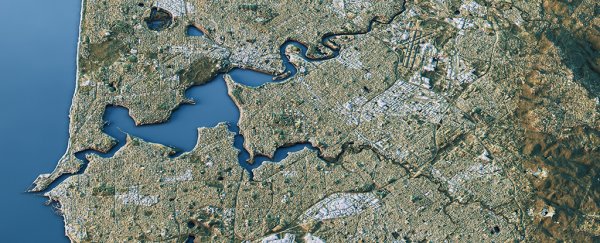You can add river erosion to the list of geological triggers capable of setting off an earthquake, according to new research: and it could help explain the reason why so many earthquakes occur far away from the edges of tectonic plates.
Those slabs of rock, and the friction and pressure that builds up as they move up against each other, are what we would normally think of as being behind seismic activity. What this latest study shows, through computer modelling matched with actual data, is that rock removed by the flow of rivers could have an impact, too.
As rivers cut through rock over the course of millions of years, that could allow the underlying crust to move more easily, the researchers say – and it could help us predict these intraplate earthquakes more accurately in the future.
"We're taught in introductory geology that the vast majority of earthquakes occur at plate tectonic boundaries, such as in Japan and along the San Andreas fault zone," says one of the team, Ryan Thigpen from the University of Kentucky.
"While this is true, it doesn't explain those earthquakes that frequently occur in areas such as the East Tennessee and New Madrid seismic zones."
Thigpen and Sean Gallen, from Colorado State University, came up with a computer model that simulated the removal of 150 metres (nearly 500 feet) of rock via river erosion – about the amount of rock cut away by the Tennessee River in eastern Tennessee over the past 9 million years or so.
That's a lot of weight shifted, and the results they came up with matched the seismic activity that's been seen in the area over the last century, suggesting they're on to something.
Intraplate earthquakes have their own particular hotspots, which has scientists thinking that there's something special about these areas, far from plate boundaries – a certain weakness in the crust added to stress built up at these weak points.
River erosion might be the missing ingredient that seismologists haven't yet considered, at least in some locations. It pushes existing faults and stresses in the crust beyond breaking point, eventually triggering an earthquake.
In the case of eastern Tennessee, the erosion – totalling about 8 trillion tons of rock – is adding to the patchwork of geological fault scars that have built up in the Appalachian Mountain region over millions of years.
The last significant earthquake in Virginia, hitting a 5.8 magnitude, happened in 2011.
Each region will have its own characteristics of course, but experts have previously suggested the same combination could be causing earthquake activity in Missouri.
If long-term rock erosion caused by rivers can be added to the earthquake models we've got, then we're potentially talking about being able to save lives as well as property if quakes can be predicted with greater accuracy in the future.
"Previously, geologists have speculated about some of the driving mechanisms behind the seismicity but new and sometimes radical ideas are now allowing us to consider this from an entirely new perspective," says Thigpen.
The research has been published in Geophysical Research Letters.
